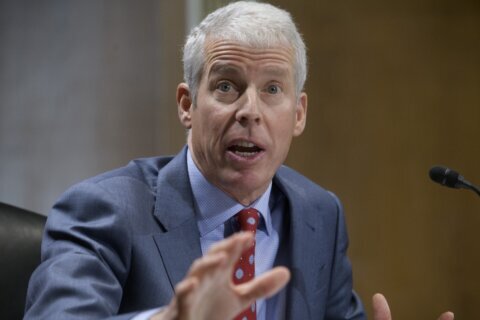Life is expensive, and managing money is complicated.
If you’re feeling burned by the high cost of living and you need help, consider asking the government for financial assistance.
Read on for information on programs that essentially amount to free money from the government for things like paying for college, child care, rent and more. Plus, get tips on how to avoid scams.
1. Temporary Assistance for Needy Families
Also known as welfare, Temporary Assistance for Needy Families (TANF) may have a negative connotation for some, but the cash assistance it provides is a financial lifesaver for many.
How much you’ll receive depends on the state in which you live. For example, in Oklahoma, the maximum amount an adult and two children can receive is $292 per month, according to Benefits.gov. According to the Washington State Department of Children, Youth & Families family of three in Washington, assuming they have no other income, would receive $654 a month.
You apply for TANF through your state’s administering agency, and to be eligible, you need to have a low income; keep in mind that states have different definitions of low income.
2. Supplemental Nutrition Assistance Program
If you’re eligible for Supplemental Nutrition Assistance Program (SNAP) benefits, previously known as food stamps, your state will issue you an electronic benefits transfer card that works like a debit card. You can use the card at authorized stores to buy food for your household.
To be eligible for SNAP, your household must meet net and gross income limits based on size. The average benefit per person is around $189 a month, according to the Center on Budget and Policy Priorities.
[Read: What Are Food Stamps and How Do I Access Them?]
3. Free or Low-Cost School Lunches
If you’re a low-income household, your kids may be eligible for free or reduced-price meals school. According to the School Nutrition Association, for the 2024-2025 school year, a family of four earning $40,560 a year or less is eligible for free meals. The same size family earning $57,720 or less would be eligible for reduced-price meals.
You can check income eligibility at the Federal Register, but keep in mind the guidelines can be a little confusing. You can always contact your child’s school to ask if you’re eligible.
4. The Child and Adult Care Food Program
The Child and Adult Care Food Program (CACFP) offers reimbursements for nutritious meals and snacks to eligible children and adults who are enrolled for care at participating child care centers, day care homes and adult day care centers.
You can find out if you’re eligible by visiting the National CACFP Association.
5. Low-Income Home Energy Assistance Program
The Department of Health and Human Services oversees the Low Income Home Energy Assistance Program (LIHEAP), which provides grants to people to help with utility bills.
Each state decides whether a household is eligible for a grant, but anyone who is already enrolled in a program like SNAP has a chance of being automatically eligible, according to Benefits.gov.
[READ: Does Lowering the Thermostat Really Save You Money?]
Grants, which are typically based on income, how many people live in the home and the type of fuel used to heat or cool the home, have ranged from $500 to $1,500 in the last few years and are paid directly to the utility.
“Unlike SNAP, LIHEAP funds are first-come first-served, so act quickly,” says Sophie Raseman, head of financial solutions at Brightside, a financial services company. “Google your state’s LIHEAP program to see if it’s currently accepting applications.”
6. Child Care and Development Fund
The Child Care and Development Fund is designed for low-income families who need assistance paying for child care due to work, school or training related to work.
If you consider yourself middle income, you may think you make too much money to qualify, but check to see if you’re eligible at Benefits.gov.
[Read: Why Is the Middle Class Shrinking?]
7. Down Payment Assistance Programs
If homeownership seems financially in reach if only you had a helping hand, look into homebuyer programs that offer down-payment assistance. You may find a program that offers a grant for a down payment (free money), a zero-interest forgivable loan (also free money) or a low-interest loan (cheap money). There are also programs that offer to help with closing costs.
Check with your city or county’s government office to find out about programs offering down-payment assistance. The U.S. Department of Housing and Urban Development website also has a lot of information regarding state and local government first-time home buying and down-payment assistance programs.
8. Pell Grant
If you have a child going to college soon, have them apply for the Pell Grant at Fafsa.gov. It can be a little overwhelming, but the financial aid virtual assistant can help. If eligible for the federal Pell Grant, your child could get up to $7,395 for the 2024-2025 school year — and that’s money they don’t have to pay back.
9. Supplemental Security Income
Supplemental Security Income (SS) is a federal program that helps disabled adults and kids who have low income and few resources. The Social Security Administration runs the program, but the money beneficiaries receive isn’t funded with Social Security taxes.
According to the SSA, the monthly maximum an eligible individual could receive in 2024 is $943. An eligible individual with an eligible spouse could receive $1,415. An essential person — someone who lives in the home and takes care of the eligible individual — could receive $472.
10. National Association of Unclaimed Property Administrators
Unclaimed.org is run by the National Association of Unclaimed Property Administrators (NAUPA), a network within the National Association of State Treasurers.
If you have lost or unclaimed money — whether it’s tens of thousands of dollars in unclaimed life insurance benefits or $11.50 that you didn’t realize was in an abandoned checking account — you may find it here.
MissingMoney.com is a website endorsed by NAUPA, and it’s also worth checking out. According to NAUPA, states are holding onto the unclaimed money and assets of 1 out of every 7 Americans and return over $4 billion a year.
11. Healthcare.gov
If you’re able to get a health insurance plan from the government for a lower cost than you could get elsewhere, you’re technically getting free money — even if you’re still forking over a hefty premium. Exactly how much you’ll save — or if you’ll save — depends on your household.
12. Unemployment insurance
Yes, you pay into unemployment insurance, and if you receive it you’ll pay taxes on it. That said, if you’re out of work and need income, this is a way to get no-strings attached money from the government.
Generally, you’ll file a claim with your state’s unemployment office website and you can always call them if you have trouble applying.
13. Social Security Disability Insurance benefits
In order to qualify for Social Security Disability Insurance, you’ll typically need to have paid into Social Security through FICA taxes for at least five of the last 10 years. You also need to have a disability that prevents you from working and earning income above what the government calls “substantial gainful activity.”
There are many rules to qualify for this benefit, which you can explore on the Social Security website.
14. Special Supplemental Nutrition Program for Women, Infants, and Children
WIC is a federal grant program that provides women and their children under five years of age with healthy food as well as nutritional counseling and referrals to various health, welfare and social service agencies.
It’s for women who have a low income, falling at or below 185% of the U.S. poverty income guidelines, according to the Food and Nutrition Service U.S. Department of Agriculture website. What you’ll receive varies, but an eligible mom with two kids would receive $919 a week.
15. Free Tax Help
There are a lot of places to get free tax help, and the Internal Revenue Service (IRS) is on the list. It’s not exactly free money they’re doling out, but if you can get free tax help, that’s money you don’t need to spend on a tax professional or software service.
IRS Free File is tax preparation software that can guide you through the process of filing your taxes — provided your adjusted gross income is $79,000 a year or less.
How to Avoid Scams
Government agencies exist to help the public. Bad actors pretending to be government agency officials, however, want to bleed you dry.
Here are a few tips regarding how to tell the good guys from the bad guys:
Check that the program’s legit. You can solve a lot of problems if you “always double-check the program’s legitimacy,” says Adnan Mahmud, CEO of FORWARD Platform, a program administration solution provider for local and state governments.
“Visit the official government website or contact the relevant agency to confirm it’s real,” Mahmud says.
So, if you’re contacted by a government official (note that government agencies typically contact consumers only if they have a preexisting relationship), before you give out any personal information, visit your favorite search engine and look up everything you can about the agency.
Don’t send money. “Be cautious of unknown programs making unrealistic promises or asking for upfront payments,” Mahmud says.
Note that the U.S. Department of Health and Human Services website states, “No legitimate federal government employee would ever call you and tell you that you qualify or have been approved for a grant for which you never applied.”
Submit information through the official secure application portal. “Use official channels and documentation provided by the government. Avoid unofficial websites or platforms for submitting personal information,” Mahmud says. “If submitting applications online, look for secure protocols, such as HTTPS, to ensure your data is protected.”
If you look at the URL on this article, for instance, you’ll notice it has the word “https” at the beginning. The “s” stands for “secure.” If you notice you’re giving information to a site that reads, “http,” stop what you’re doing and leave the website.
If it’s too good to be true, it probably is. The Federal Trade Commission website says that lately scammers have been posing as lottery winners on social media, saying they want to share their fortune with some lucky people. They’ll write things like, “I’m giving away $50,000 to the first 1,000 people to message me.” If you give out your personal information, you can imagine what might happen.
More from U.S. News
How to Get Free Money as a Student
15 Ways to Get Free Money from the Government originally appeared on usnews.com
Update 07/19/24: This story was previously published at an earlier date and has been updated with new information.













